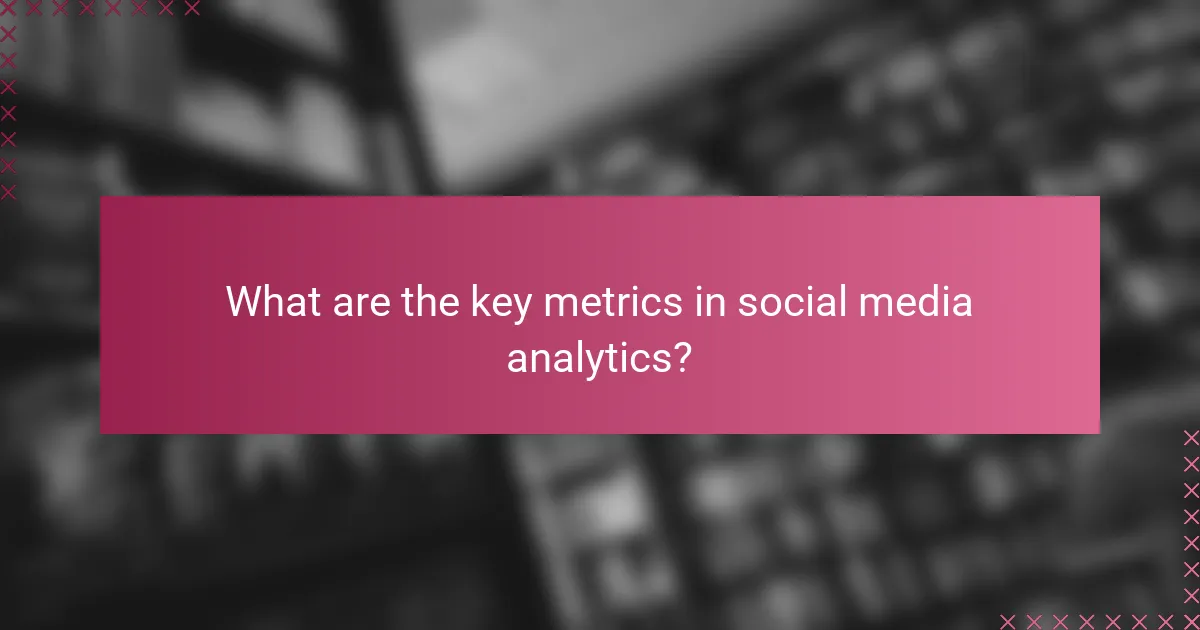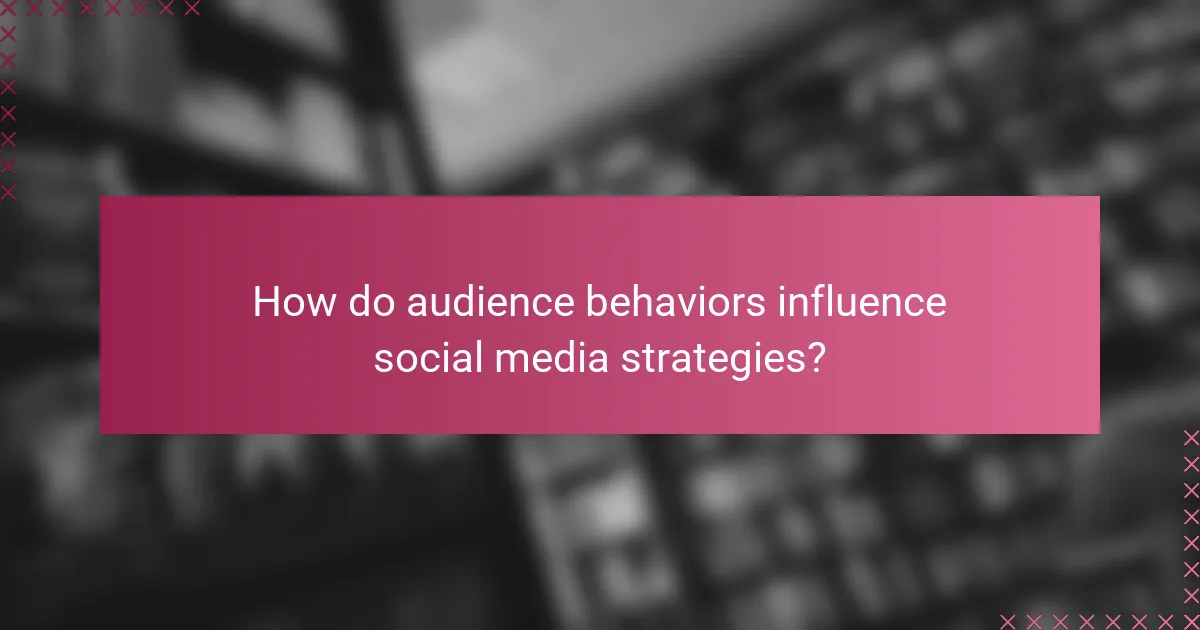Social media analytics plays a crucial role in enhancing e-commerce performance by offering insights into customer behavior and engagement patterns. By analyzing key metrics such as engagement rate and conversion rate, businesses can refine their marketing strategies and optimize ad spend to boost sales and customer satisfaction. Understanding audience behaviors further allows brands to tailor their content and outreach for maximum impact.

How can social media analytics improve e-commerce performance?
Social media analytics can significantly enhance e-commerce performance by providing valuable insights into customer behavior, preferences, and engagement patterns. By leveraging these insights, businesses can tailor their marketing strategies, optimize ad spend, and ultimately drive higher sales and customer satisfaction.
Enhanced customer insights
Social media analytics allows e-commerce businesses to gather detailed information about their customers, including demographics, interests, and purchasing habits. This data helps in understanding what products resonate with different segments of the audience, enabling more personalized marketing efforts.
For example, analyzing engagement metrics can reveal which posts generate the most interest, guiding businesses to create content that aligns with customer preferences. Additionally, tools like sentiment analysis can help gauge customer opinions about products or services, informing product development and customer service strategies.
Optimized marketing strategies
With insights from social media analytics, e-commerce brands can refine their marketing strategies to target the right audience more effectively. By identifying which platforms yield the highest engagement, businesses can allocate resources to the channels that deliver the best results.
Testing different types of content, such as videos or infographics, and analyzing their performance can help brands understand what drives conversions. This iterative approach allows for continuous improvement in marketing campaigns, ensuring that messaging resonates with the intended audience.
Increased engagement rates
Utilizing social media analytics can lead to higher engagement rates by enabling brands to create content that captivates their audience. By tracking likes, shares, and comments, businesses can identify trends and adjust their content strategies accordingly.
For instance, if a particular product post garners significant interaction, similar content can be produced to maintain momentum. Engaging with customers through comments and direct messages also fosters a sense of community, encouraging repeat interactions and brand loyalty.
Data-driven decision making
Data-driven decision making is crucial for e-commerce success, and social media analytics provides the necessary data to inform these decisions. By analyzing performance metrics, businesses can identify what works and what doesn’t, allowing for informed adjustments to marketing tactics.
For example, if a specific ad campaign shows low conversion rates, businesses can pivot their approach based on the insights gained. This proactive strategy minimizes wasted resources and maximizes the effectiveness of marketing efforts.
Improved ROI on ad spend
Social media analytics can lead to improved return on investment (ROI) for ad spend by allowing businesses to target their advertising more precisely. By understanding which demographics respond best to certain ads, e-commerce brands can allocate their budgets more effectively.
Implementing A/B testing on ads can further enhance ROI by identifying the most effective messaging and visuals. Regularly reviewing ad performance metrics ensures that businesses can quickly adapt to changing market conditions and customer preferences, ultimately leading to more efficient spending.

What are the key metrics in social media analytics?
Key metrics in social media analytics include engagement rate, reach and impressions, conversion rate, and follower growth. These metrics help businesses understand audience behavior, measure content effectiveness, and optimize their social media strategies.
Engagement rate
The engagement rate measures how actively users interact with your content, typically calculated as the total engagement (likes, comments, shares) divided by total followers or reach. A higher engagement rate indicates that your audience finds your content relevant and appealing.
To improve engagement, focus on creating high-quality, shareable content that resonates with your audience. Aim for an engagement rate of around 1-5% for most platforms, but remember that benchmarks can vary by industry.
Reach and impressions
Reach refers to the total number of unique users who see your content, while impressions count the total number of times your content is displayed, regardless of whether it was clicked. Understanding both metrics helps gauge the visibility of your posts.
To maximize reach, consider using targeted ads and optimizing posting times. A good practice is to monitor both metrics regularly to identify trends and adjust your content strategy accordingly.
Conversion rate
The conversion rate measures the percentage of users who take a desired action after engaging with your content, such as making a purchase or signing up for a newsletter. This metric is crucial for assessing the effectiveness of your social media campaigns.
To improve conversion rates, ensure your calls-to-action are clear and compelling. A typical conversion rate for social media can range from 1-3%, but this can vary significantly based on industry and campaign specifics.
Follower growth
Follower growth tracks the increase in your social media audience over time, reflecting the effectiveness of your marketing efforts. A steady growth rate indicates that your content is attracting new users and retaining existing ones.
To boost follower growth, consistently post engaging content and interact with your audience. Aim for a monthly growth rate of around 2-5%, but adjust your goals based on your current follower count and industry standards.

How do audience behaviors influence social media strategies?
Audience behaviors significantly shape social media strategies by dictating what content resonates, when users are most active, and which demographics to target. Understanding these behaviors enables brands to tailor their approach for maximum engagement and effectiveness.
Content preferences
Content preferences vary widely among audiences, influencing what types of posts receive the most interaction. For instance, visual content such as images and videos often garners higher engagement compared to text-only posts. Brands should analyze past performance to identify which formats—like infographics, live videos, or user-generated content—appeal most to their followers.
To optimize content, consider conducting surveys or polls to directly ask your audience about their preferences. This feedback can guide content creation and help ensure that your posts align with what your audience wants to see.
Peak engagement times
Identifying peak engagement times is crucial for maximizing visibility and interaction on social media. Generally, users are most active during early mornings, lunch hours, and evenings, but these times can vary based on the target demographic and platform. For example, B2B audiences may engage more during weekdays, while B2C audiences might be more active on weekends.
Utilize analytics tools to track when your audience is online and adjust your posting schedule accordingly. Experimenting with different times can help pinpoint the optimal moments for sharing content, leading to increased engagement rates.
Demographic insights
Demographic insights provide essential information about the characteristics of your audience, such as age, gender, location, and interests. This data helps tailor content and advertising strategies to better resonate with specific groups. For example, younger audiences may prefer platforms like TikTok, while older demographics might engage more on Facebook.
To gather demographic insights, leverage social media analytics tools and insights provided by the platforms themselves. Regularly reviewing this data allows for adjustments in targeting and messaging, ensuring that your social media strategies remain relevant and effective.

What tools are best for social media analytics?
Several tools excel in social media analytics, each offering unique features to track performance, audience engagement, and trends. The best choice depends on your specific needs, such as the platforms you use and the depth of analysis required.
Hootsuite
Hootsuite is a comprehensive social media management platform that provides robust analytics features. It allows users to track engagement metrics across multiple social networks, offering insights into follower growth, post performance, and audience demographics.
One key advantage of Hootsuite is its ability to schedule posts and analyze their performance in real-time. This helps businesses optimize their content strategy based on what resonates most with their audience.
Sprout Social
Sprout Social is known for its user-friendly interface and powerful reporting capabilities. It offers in-depth analytics on engagement, impressions, and audience demographics, making it easy to understand how content performs across different platforms.
This tool also includes social listening features, allowing brands to monitor conversations about their products or services. By leveraging these insights, businesses can adjust their strategies to better meet audience expectations.
Google Analytics
Google Analytics is primarily a web analytics tool but offers valuable insights into social media performance as well. By linking social media campaigns to website traffic, users can track how social interactions drive conversions and user behavior on their sites.
To effectively use Google Analytics for social media, set up UTM parameters for your links. This allows you to see which platforms and posts generate the most traffic and engagement, helping you refine your marketing efforts.
Buffer
Buffer is a straightforward tool for scheduling posts and analyzing their performance across various social media channels. Its analytics dashboard provides insights into engagement rates, click-through rates, and audience reach.
One of Buffer’s strengths is its simplicity, making it ideal for small businesses or individuals who may not need extensive features. However, it’s essential to regularly review analytics to adjust your posting strategy and maximize engagement.
